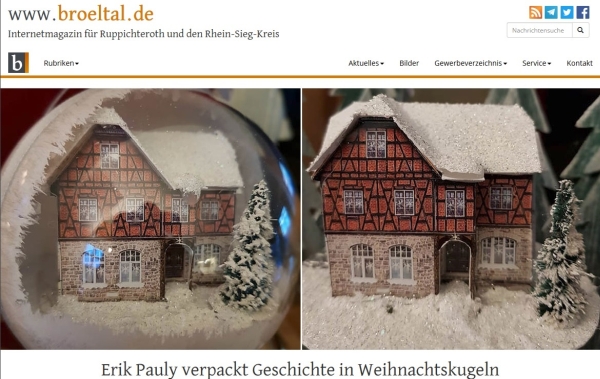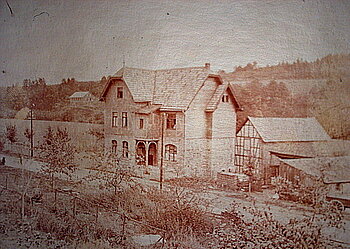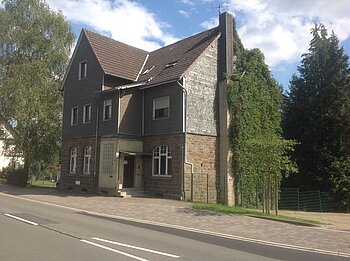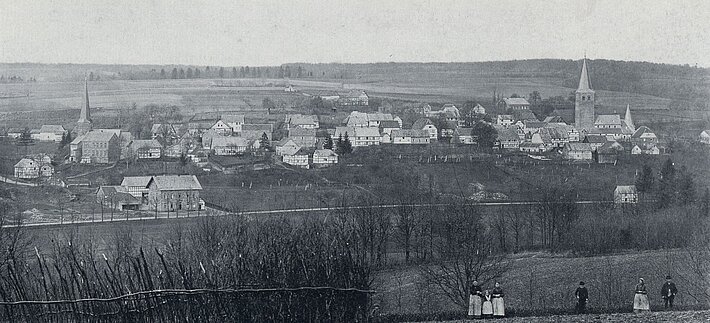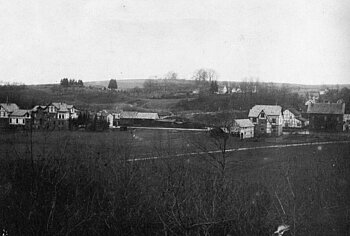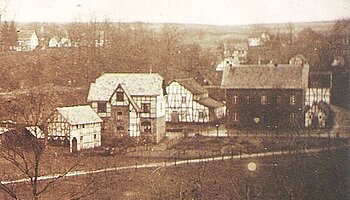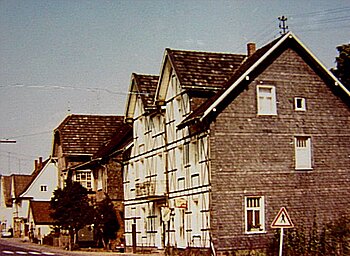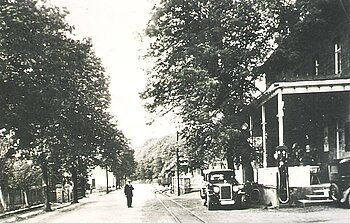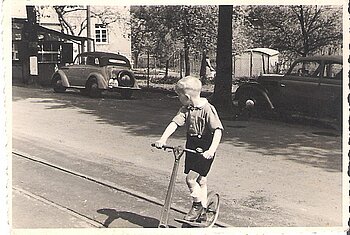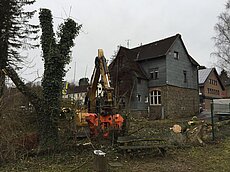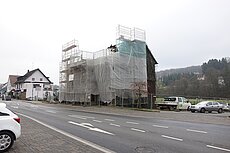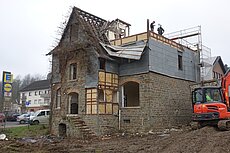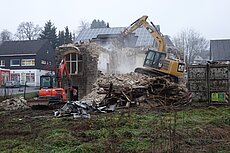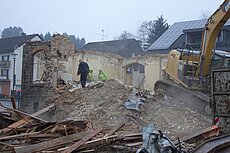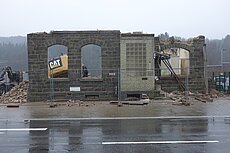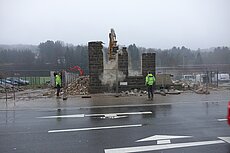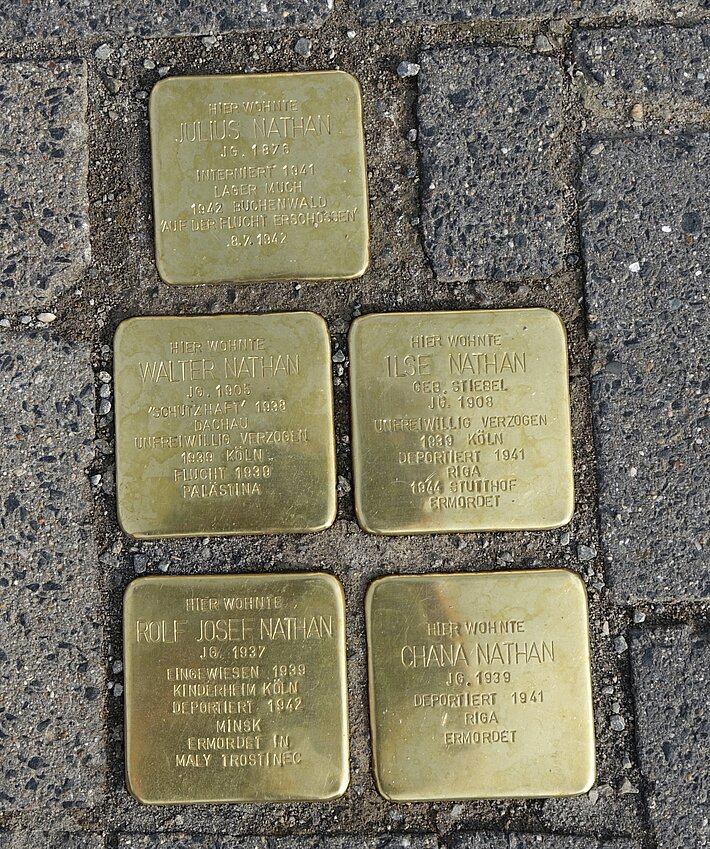The former Nathan house / Pach house
The report on broeltal.de of December 12th, 2020 about the beautiful, artistically designed Christmas balls by Erik Pauly has motivated the author of these lines to add one more aspect to the history of the house presented there: the story of the family who built it and their fate .
For those who like it short;:
The house was built around 1900 by the Jewish Nathan family, whose ancestors had lived in Ruppichteroth since 1846. Of the five people in the Nathan family who lived here between 1939 and 1941, four were murdered by the Nazis, and one person escaped by fleeing to Palestine.
And here is the story in detail:
It must be said in advance that the hisstory of the Nathan has to be partially revised in a few places compared to earlier information (also on bilderbuch-ruppichteroth.de) due to new research:
The house was built between 1870 and 1900 by the Jewish Nathan family. The Nathans were butchers, cattle dealers, and farmers. The farm buildings were behind the house. The front part was used as a residential building.
Unlike occasionally reported (most recently in an article in a local daily newspaper in 2019), the origin of the place Ruppichteroth is not on Brölstrasse (Bröl-Valley-Steet), but in the upper village between the two churches. Many towns in the Bröl-Valley were founded "on the hills" (including Schönenberg, Benroth, Berkenroth) because the Bröl floodplains were often flooded. In the already difficult times of the past one could at least avoid the problem of floods and the diseases resulting from them when building the houses on the hills.
In addition, the Brölstraße was not built until 1862, the section to Ruppichteroth was inaugurated on September 15, 1862. Until then, the route to Hennef or Waldbröl (but who wanted to go there at the time? And why?) led over the Nutscheid, although the route was often unusable in bad weather.
Ruppichteroth 1861 or 1862 - still without the Nathan house
The picture above - in various publications repeatedly described as "approx. 1895 “- shows the then almost undeveloped Brölstrasse without the Nathan house. When you enlarge the picture you can see that the rails for the 1863 Bröltalbahn (train) line have not yet been laid here. The correct date of these pictures is probably around 1861. For his research on the so-called Ispert House, Lothar Willach asked the deceased former owner of the Hotel zur Krone, Helmut Zimmermann. Helmut Zimmermann said that the Hotel zur Krone was built as a train station hotel by Anton Heider. This was evidenced by a stone on the base of the house with the inscription "Heider 1860". Anton Heider was a far-sighted businessman: when he heard about the planned construction of the Brölstraße and the Bröltalbahn years beforehand, he built a house with a hotel and later also a bowling alley next to the train station in 1860. The picture is therefore from after 1860 and before 1863.
The Nathan house from different perspectives
The Nathan family
We have detailed information about the last owner, Julius Nathan, who was murdered by the Nazis.
His ancestors come from Niederelbe (then the municipality of Marienberghausen). His grandfather Nathan Nathan was born there on April 28th, 1814, as the son of the butcher Josef Nathan. In 1846 he married Caroline Kahn from Ruppichteroth and settled here as a manufactured goods dealer and butcher.
Nathan's son Jacob, (born February 25, 1850 in Ruppichteroth, died here on July 6, 1935) married Helena Strauss from Dierdorf on August 23, 1875 (born September 22, 1847 in Dierdorf, died July 2, 1924 in Ruppichteroth)
It can therefore be assumed that the builder of the house, which was built between 1870 and 1900, was probably Jacob Nathan (he was 50 years old in 1900), possibly, but less likely, his 1900 24-year-old son Julius.
The last Jewish owner: Julius Nathan - the last Jewish family
Julius was the son of Jacob and Helena Nathan. He was born on 08/07/1876 in Ruppichteroth and was a cattle dealer. His wife Ida (born on June 9th, 1877) died on December 10th, 1936 in Cologne-Ehrenfeld.
Julius and Ida Nathan had 2 children:
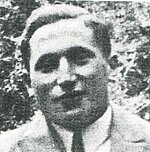
Son Walter Nathan, born on May 24th, 1905 in Ruppichteroth, married Ise Stiebel on January 27th, 1937, born on November 4th, 1908.
Daughter Gertie Nathan, born on November 30th, 1906 in Ruppichteroth, married Max Hahn, born in Schweinfurt, in 1930.
Walter and Ilse had 2 children:
Son Rolf Josef (born Nov. 24, 1937) and daughter Chana (Hanna, born April 11, 1939)
A wealthy family
The Nathans were a wealthy family. Not only the size of the house, the ground floor in quarry stone masonry, behind it brick walls, 2 upper floors in the artful half-timbered style, large windows with round arches, on the back even made of red clinker bricks, but also the demarcation to the street by wrought grids and columns as well as the large garden next to the house made the house and property one of the most beautiful areas in Ruppichteroth. The farm buildings behind the house ensured the prosperity that can be seen here. It was only through research in 2019 that it became known that the Nazis also confiscateda car owned by Julius Nathan (an Opel P4), which in Ruppichteroth otherwise only the two merchants Walter Schumacher and Josef Schorn, the dentist Dr. Wilhelm Ritter and the hotelier Albert Zimmermann drove. So it is very obvious that the Nathan family belonged to the wealthiest families in Ruppichteroth.
Hans Ottersbach (Schönenberg) about the Nathan family:
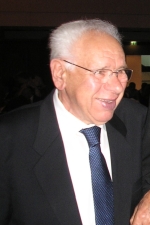
... I come from a believing family. In my parents' house it was the order of the day that everyone, wherever they came from, whatever beliefs they had, was treated with respect. The first time that I was consciously confronted with the fact that something was "going on" with the Jewish fellow citizens was in January 1935. I traveled with my mother Maria Ottersbach - a native of Saarland - to the Saar referendum. The Jewish Nathan family, who lived in what is now the Dr. Pach house asked us to take a package with us to their relatives in Lorraine to keep a few things safe. My mother and I didn't know what was in the package. It went without saying that we should comply with this request. We knew the Nathans well and lived with them on friendly terms, like many Ruppichteroth citizens. Most of them didn't care that they were of Jewish faith ...
Fates of the Nathan family
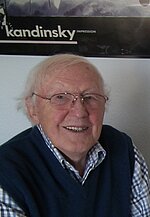
Julius Nathan was taken to the Much camp on June 18, 1941 and deported to Cologne, Messehalle, on July 18, 1942. On the way to the Weimar-Buchenwald concentration camp, Julius N. was "shot while trying to escape" in 1942 at the age of 66. His death was reported to the "Command of the K.L. Buchenwald ” as follows: “The pol. Jude Julius Israel Nathan, born on August 7th, 1876 in Ruppichteroth / Rhld. was shot today at 7:35 am while trying to escape ”. (Source: www.fold3.com/image/232100311)
Heinrich Schöpe (formerly residing in Velken, today in Bonn), who for bilderbuch-ruppichteroth.de described numerous stations in his life during the Nazi period, knew Julius Nathan personally through his father. Heinrich Schöpe writes for bilderbuch-ruppichteroth.de: “My father has just repeatedly done fair cattle-buying deals with Julius Nathan. That was done with a handshake. As long as the Jews were not persecuted, there was a lively livestock market every 14 days in Waldbröl, which however then fell sharply. My mother once said: “You did better business with the Jews”. One day Nathan came to my father and said to him - I happened to be there -: "Yes, Karl, we will see each other for the last time". A sad farewell! Because Nathan soon behaved in the group as unruly and certainly also incitatory, he was soon sorted out and not sent on with the group, but came to the Buchenwald concentration camp, where he was shot. It's terrible how the Nazis treated Jews and other people who were not well-disposed towards them ”(email of March 8, 2017).
Walter Nathan moved - like other Jewish fellow citizens from Ruppichteroth, probably in anticipation of upcoming events - on April 11, 1939 with his family to Cologne.
There the family was separated.
After the so-called “Kristallnacht” (November 10th, 1938) Walter Nathan was imprisoned in Dachau from November 15th to 28th, 1938. After his release he was given permission to leave Germany. He died in Israel in 1970.
Mother Ilse and the three-months-old daughter Chan (Hanna) were sent to Cologne Ehrenfeld, Gutenbergstrasse 66. Mother and child died in the concentration camp.
Son Rolf Josef came to the Lützowstrasse children's home in Cologne on April 11, 1939 at the age of one and a half years. He was deported on December 7th, 1941 and killed in the killing site Minsk Maly Trostinec.
Walter's brother-in-law Max Hahn is recorded to have arrived in Auschwitz on December 7th, 1943. Nothing is known about his further fate. His wife Gertie - Walter's sister - was able to escape to England.
Further history of the house of the Nathan family
After the families were expelled by the Nazis (often referred to as "Aryanization" or "De-Judaization"), sometimes even before the expulsion, the Jewish owners were expropriated and the house and farm as well as the objects belonging to them were often far below the actual value as quickly as possible Value price - in Ruppichteroth often with the help of the "non-profit settlement society for the Rhine province" - handed over to the new owners. Sometimes the Jewish owners sold themselves to interested villagers in their distress, especially in order to get the money they needed to leave the country (destination was mostly the USA).
For the former Haus Hess (Wilhelmstrasse) I was able to document such a transfer of Jewish assets with the help of the existing files in detail and with figures.
No such files have yet been viewed for the Nathan house.
But what is known:
Neighbor Helmut Zimmermann reports in his memoir (“What I always wanted to tell you”, 2016, self-published) that a Schewe family moved into the previous Nathan house as early as 1939: “The Schewe family came to Ruppichteroth in 1939 and lived in the house ( now Dr. Pach). Mr. Schewe worked in a leading position in the Willach Brothers company. He was drafted into the Wehrmacht in 1939 because he was a reserve officer. Sheves had 3 daughters. "
It is not known who was the first post-owner of the house Nathan and in what form the transition took place.
Several contemporary witnesses have reported that the house and property (to the east almost to the pharmacy) were acquired in the early 1940s by a pastor Schlauder from an Eifel town who was in contact with Ruppichteroth through his domestic servants from Ennenbach. This pastor was therefore also the owner of the little shop run by Elisabeth Wüllenweber.
From 1944 to 2015 the house was used as a doctor's practice.
- Dr. Ohlemüller (1944-1979)
- Dr. Pach (1979-2011)
- Dr. Bartolic (2011-2015)
The farm buildings behind the house were used by Hans Schardt for his paint wholesale business from 1945 to the beginning of the 1950s (see address book of the Rhein-Siegkreis, 1950 edition, and information from Reinhold Altwicker). The telephone number in this address book is number 170. These were also owned by Heinz Zünder (radio / television), the Kurt Stumm bicycle and motorcycle workshop, both of which had their workshops in the back yard of the Hotel zur Krone, and the Hotel zur Krone himself, where the phone was, according to statements by Helmut Zimmermann. In practice, this means that when a call came in, the Zimmermann family had to go to the person called and ask them to answer the phone, in the case of Hans Schardt even to the other side of Brölstrasse.
Up until the 1970s (or even longer?) The Kummer family lived on the upper floor, and they also used and looked after the garden between the house and the little shop.
2017: The demolition of the house
Today there is a branch of the VR-Bank Rhein-Sieg.
Quellen: bilderbuch-ruppichteroth.de, Karl Schröder, Die Juden in Eitorf und Ruppichteroth, 1974
Bilder: Archiv Alois Müller, Helmut Zimmermann, Wolfgang Eilmes

